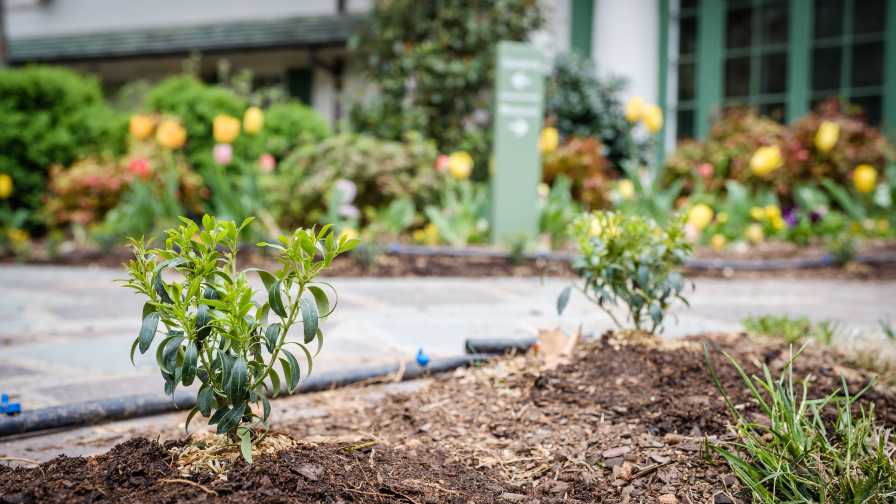How One Historical Greenspace is Responding to Boxwood Blight

Members of the Wake Forest community and residents of Winston-Salem plant 300 gem box holly shrubs along the garden borders at Reynolda Gardens House Museum of American Art as part of Pro Humanitate Days on Monday, April 8, 2019.
Boxwood blight is on the verge of wiping out generations-old plants across the southeast. In the fall of 2018, boxwood blight hit Wake Forest University’s Reynolda Gardens, prompting experts to connect with Spring Meadow Nursery to identify a boxwood replacement that is both consistent with the historic landscape and resistant to disease.
Boxwoods have long been a critical design feature of the Reynolda landscape, framing the forecourt of south façade of the bungalow since 1937. The boxwoods in landscape architect Thomas Sears’s original plans were English dwarf boxwoods; however, this species was problematic and was replanted several times without success.
Then, in 2015 as part of its landscape restoration project, Reynolda replanted the forecourt with Justin Brouwers boxwood, also called Korean dwarf boxwood and affectionately known as the “baby boxwoods” among the Reynolda staff.
Jon Roethling, director of Reynolda Gardens, says his staff first noticed discoloration in the boxwoods along the perimeter of the forecourt garden in early fall 2018. The discoloration was soon diagnosed as blight infection. Shortly after diagnosing the boxwoods, Reynolda removed all infected boxwoods and treated all plants in close proximity to prevent fungal spread. At that time, 80 of the 300 boxwoods in front of Reynolda House were removed.
“Reynolda was not alone in seeing boxwood blight affect our plantings this fall,” says Karl Erik, Director of Operations at Reynolda House. “Landscapes in our surrounding neighborhoods and beyond also suffered. But here at Reynolda, addressing changes in our historic landscape is a particularly sensitive task that we approach with caution, and in consultation with experts in the field.”
Erik and Roethling talked with historic garden specialists, researched how other sites were dealing with the blight and ultimately connected with Tim Wood, the Product Development Manager at Spring Meadow Nursery in Grand Haven, MI. Wood agreed to provide Reynolda with a recommended replacement for the boxwoods, Proven Winners ColorChoice ‘Gem Box’ Ilex Glabra (inkberry holly). Ilex is proving to be a successful boxwood alternative in Europe, and Wood hopes Reynolda might become a case study for boxwood replacements in North American historic landscapes.
“Reynolda is our first large-scale public test in the states, so we’re excited to be involved,” Wood says. “Boxwood blight has been devastating in Europe. We have been testing alternatives in France where huge numbers of boxwood plants were used in palace, castle, and chateaux gardens as low hedges, called parterres.
The successful use of inkberry holly as a boxwood replacement in historical European sites made a convincing case for choosing the dainty evergreen shrub to replace the failing boxwoods at the historic Wake Forest University site. And in April of 2019, a team of volunteers replaced all 300 boxwood plants in front of Reynolda House with Gem Box inkberry holly.
“There is a long history of this landscape being progressive and adapting to change,” Roethling says. “The decisions we make today about how to address this epidemic puts Reynolda at the forefront of demonstrating approaches for responding to our changing environment.”
Reynolda’s responsibility is to both maintain the integrity of the original landscape design and character, and respond to the changing needs of the environment, Roethling says.
“We’ll be watching these new plants closely and sharing information with the nursery and our colleagues working in other historic landscape and gardens,” he says.










